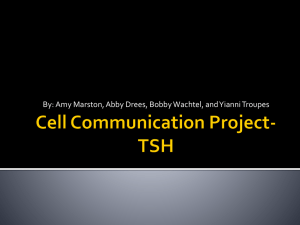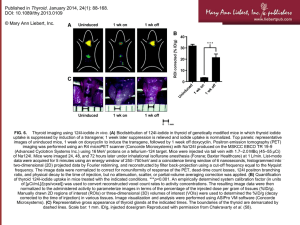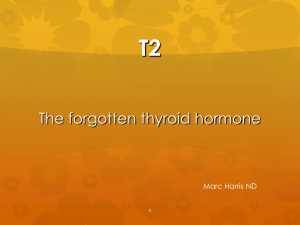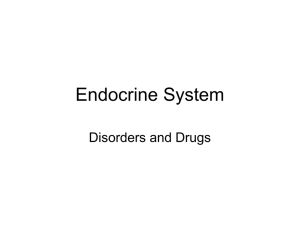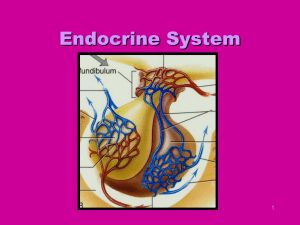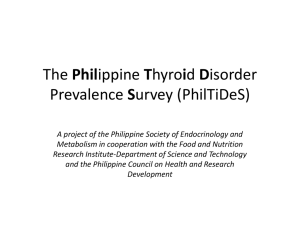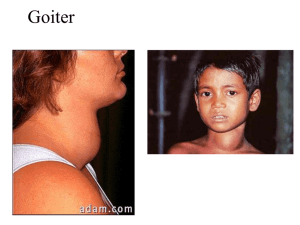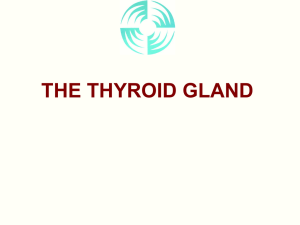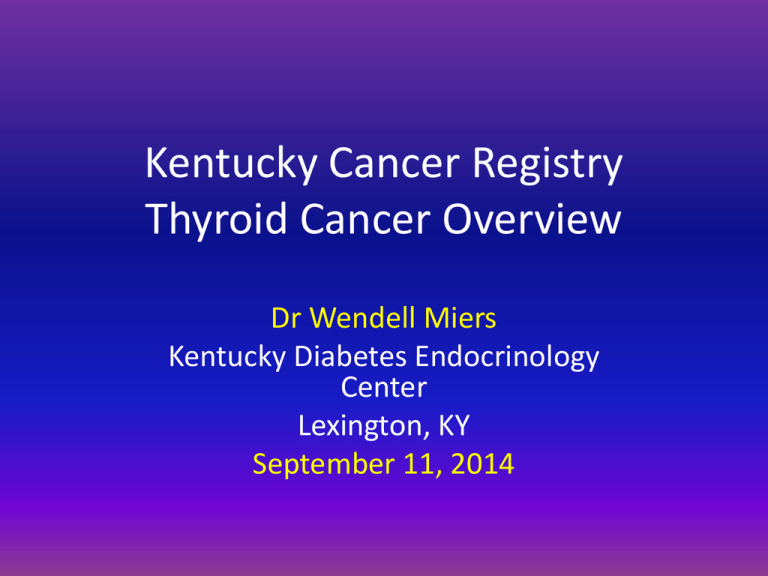
Kentucky Cancer Registry
Thyroid Cancer Overview
Dr Wendell Miers
Kentucky Diabetes Endocrinology
Center
Lexington, KY
September 11, 2014
OVERVIEW
•
•
•
•
•
•
Thyroid gland/Nodules
Diagnosis of Thyroid Cancer
Types of Thyroid Cancer
Staging
Treatment
Surveillance
THYROID ANATOMY
THYROID HISTOLOGY
THYROID NODULES
• Thyroid nodules are fairly common - upwards
of 20% of the population will have thyroid
nodules
• Incidence of nodules increases with age
• Risk of cancer in a thyroid nodule ~5%
• Larger size of nodule (>2cm) increases risk of
thyroid cancer
• History of head and neck radiation increases
risk of cancer
DIAGNOSIS OF THYROID CANCER
• Typically presents as painless thyroid nodule
• Discovered by patient, health care provider on
routine exam, or as incidental finding on
imaging study
• Can occur at any age but risk of cancer in a
nodule is higher in children and adults age <30
or >60
• Fine needle aspiration usually next step in
diagnosis
Types of Thyroid Cancer
• DIFFERENTIATED THYROID CANCER
Papillary thyroid cancer
Follicular thyroid cancer
•
•
•
•
ANAPLASTIC THYROID CANCER
MEDULLARY THYROID CANCER
LYMPHOMA INVOLVING THE THYROID
METASTATIC CANCER TO THE THYROID
PAPILLARY THYROID CANCER
• Most common type of thyroid cancer – 75 to 80%
of thyroid cancers
• Excellent prognosis – most patients don’t die
from this – mortality rate in 1 series was 6% at 16
years
• Incidence increasing – has tripled since 1975 –
from 4.9 to 14.3 per 100,000
• Increase likely due to increase in diagnosis (?
overdiagnosis) as mortality rate has remained
stable – 0.5 deaths per 100,000
PAPILLARY THYROID CANCER
• Subtype: follicular variant of papillary thyroid
cancer – accounts for 10% of papillary cancers
– same prognosis as papillary
• Subtype: tall cell variant – accounts for 1% of
papillary cancers – more aggressive variant –
larger tumors and often invasive – higher risk
for distant metastases
PAPILLARY THYROID CANCER
HISTOLOGY
FOLLICULAR THYROID CANCER
• Second most common type – accounts for
about 10% of thyroid cancer
• Diagnosed on histopathology by invasion of
tumor capsule or vascular invasion
• May contain RAS oncogene (40%)
• Less common lymph node involvement
• Distant metastases can occur in lung or bone –
hematogenous spread
FOLLICULAR THYROID CANCER
• Prognosis for differentiated thyroid cancer – 10
year survival rate over 95% if age <40; 80% age
40 to 59
• Other prognostic factors for follicular cancer:
minimally invasive vs widely invasive on
pathology; vascular invasion; distant metastases
• Subtype: Hurthle cell cancer – worse prognosis –
less responsive to radioactive iodine – 10 year
disease free interval 41% vs 75% for follicular
cancer
FOLLICULAR THYROID CANCER
HISTOLOGY
ANAPLASTIC THYROID CANCER
• Uncommon type of cancer – annual incidence 1
to 2 per million persons – mean age at diagnosis
65 years
• Undifferentiated tumor of follicular epithelium
• Rapidly growing and extremely aggressive –
disease specific mortality of almost 100%
• Very poor prognosis – initial management
includes end of life issues and plan for comfort
care measures; median survival 3 to 7 months
• Treatment options include surgery, external beam
radiation and chemotherapy
MEDULLARY THYROID CANCER
• Tumor of C-cells (parafollicular cells) –
neuroendocrine tumor
• Accounts for about 4% of thyroid cancers
• May be part of Multiple Endocrine Neoplasia
syndrome
• Calcitonin can be used as tumor marker
• Therapy is total thyroidectomy with central neck
lymph node dissection; XRT for residual disease
• 10 year survival with biochemical cure post-op is
98%; without biochemical cure 70%
OTHER CANCERS INVOLVING THE
THYROID
• Thyroid lymphoma – uncommon cause of thyroid
enlargement – <2 % of thyroid malignancies may be presenting symptom of lymphoma
though – typically presents as rapidly enlarging
goiter
• Typically NHL – B-cell lineage
• Treated with chemotherapy and/or external
beam radiation
• Other cancers metastatic to the thyroid gland –
very rare; treatment is specific to the type of
cancer
STAGING FOR DIFFERENTIATED
THYROID CANCER
• Initial staging can estimate disease-specific
mortality
• Can help tailor treatments – need for I131 and
degree of TSH suppression
• Can help determine intensity of follow up
based on risk for recurrence or mortality
STAGING PREDICTS MORTALITY
•At the University of Chicago, the 20-year
survival rate was nearly 100 percent among
the 82 percent of patients who were
classified as stage I versus a five-year
survival of only 25 percent among the 5
percent of patients classified as stage IV .
The results were similar when this system
was applied at the Mayo Clinic.
•However, staging can’t predict risk of
recurrence in an individual patient
TREATMENT OF THYROID CANCER
•
•
•
•
SURGERY
RADIOACTIVE IODINE
SUPPRESSION WITH LEVOTHYROXINE
EXTERNAL BEAM RADIOTHERAPY
TREATMENT FOR THYROID CANCER:
SURGERY
• Initial treatment is total thyroidectomy +/central neck lymph node dissection
– May consider hemithyroidectomy if single focus of
papillary cancer < 1cm
– More extensive resection for patients with
evidence of invasion of neck structures
Surgical risks include hypoparathyroidism and
recurrent laryngeal nerve damage; usually
overnight stay after surgery to monitor calcium
TREATMENT FOR THYROID CANCER:
RADIOACTIVE IODINE
• I131 treatment has several uses: ablation of
residual thyroid tissue and any microscopic
residual cancer; imaging for possible
metastatic disease; and treatment of known
residual or metastatic disease
• Should be considered in patients with known
residual disease or at intermediate or high risk
for recurrence
TREATMENT FOR THYROID CANCER:
RADIOACTIVE IODINE
• Iodine is taken up by thyroid (and
differentiated thyroid cancer) cells – I131
emits short length beta radiation and thereby
kills cells
• Iodine uptake is facilitated by low iodine diet
and by increased TSH
• 2 options to increase TSH – withdrawal from
thyroid hormone or synthetic TSH injections
(Thyrogen)
TREATMENT FOR THYROID CANCER:
RADIOACTIVE IODINE
• Concerns with I131 treatment:
– Isolation of patients after high dose I131
– Shouldn’t be given to pregnant or nursing women
– Risk for sialadenitis
– Women shouldn’t attempt pregnancy for at least 6
months after I131 treatment
– Small absolute increase in risk of second
malignancy after I131 (leukemia or salivary gland
cancer)
TREATMENT FOR THYROID CANCER:
THYROID HORMONE SUPPRESSION
• After thyroidectomy, all patients will require
levothyroxine therapy
• Using doses of levothyroxine to suppress TSH
may minimize potential thyroid cancer growth
• For patients at low risk of recurrence, attempt
to maintain TSH between 0.1 and 0.5mU/L
• For patients at higher risk, attempt to
maintain TSH <0.1mU/L
TREATMENT OF THYROID CANCER:
EXTERNAL BEAM RADIOTHERAPY
• Used for metastatic disease
• May be used for disease that isn’t radioiodine
avid
SURVEILLANCE FOR RECURRENCE
• DYNAMIC STAGING
• Excellent response: no clinical, biochemical or
structural evidence of disease
• Biochemical incomplete response: abnormal
thyroglobulin values in the absence of localizable
disease
• Structural incomplete response: persistent or newly
identified locoregional or distant metastases
• Indeterminate response: non-specific biochemical or
structural findings that cannot be confidently classified
as either benign or malignant
SURVEILLANCE FOR RECURRENCE
• BIOCHEMICAL SURVEILLANCE: serum
thyroglobulin – stimulated vs. unstimulated
• IMAGING MODALITIES:
Neck ultrasound
Radioactive iodine whole body scanning
PET/CT
IMAGING FOR SURVEILLANCE
• NECK U/S
Advantages:
less expensive
looks at area at highest risk for recurrence
Disadvantages:
higher false positive rate
not able to identify metastatic disease
IMAGING FOR SURVEILLANCE
• RADIOACTIVE IODINE WHOLE BODY
SCANNING
Advantages:
Specific for thyroid cancer
Able to identify distant metastases
Disadvantages:
Expensive
Prep
Non-iodine avid disease
IMAGING FOR SURVEILLANCE
• PET/CT
Advantage:
Can be used for non-iodine avid disease
Disadvantages:
Expensive
Not specific for thyroid cancer/false positive
rate
SOURCES
• www.uptodate.com
• Current Thyroid Cancer Trends in the United States; Davies,
Louise and Welch, Gilbert, JAMA Otolaryngology-Head &
Neck Surgery; April 2014; Volume 140, Number 4, pp 317322
• Revised American Thyroid Association Management
Guidelines for Patients with Thyroid Nodules and
Differentiated Thyroid Cancer (2009)
The American Thyroid Association (ATA) Guidelines
Taskforce on Thyroid Nodules and Differentiated Thyroid
Cancer D.S. Cooper, (Chair), G.M. Doherty, B.R. Haugen, R.T.
Kloos, S.L. Lee, S.J. Mandel, E.L. Mazzaferri, B. McIver, F.
Pacini, M. Schlumberger, S.I. Sherman, D.L. Steward, and
R.M. Tuttle

